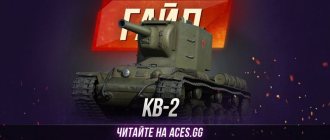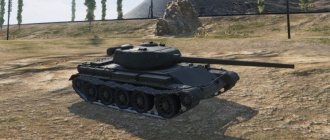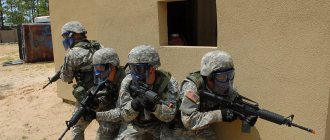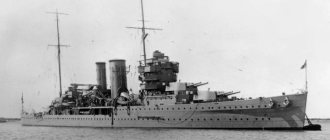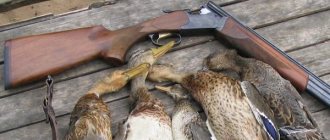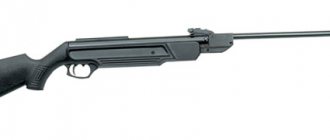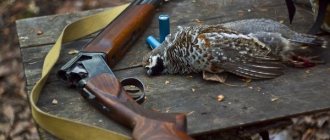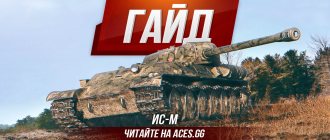Soviet heavy tank of the tenth level World of Tanks IS-4. The Soviet development tree of heavy tanks of the USSR is divided into two branches, the top of one is occupied by the IS-4. Soviet heavy armor is characterized by excellent armor, and our iron hero was no exception to this rule. However, in order to effectively run random on this tank, it makes sense to familiarize yourself with its characteristics in more detail.
- IS-4 guide
- Where to shoot the IS-4
- Equipment on IS-4
- IS-4 Perks
- How to play IS-4
- IS-4 reviews
- IS-4 video
IS-4 guide
First of all, the IS-4 has a safety margin of 2,500 units. The indicator is certainly impressive, but far from the standard for level 10. In terms of visibility, things are somewhat better - a radius of 400 meters looks quite comfortable. Let's move on to the viability of the vehicle on the battlefield. This parameter directly depends on the armor, and in this regard, the heavyweight has some problems described in the subheading of where to penetrate the IS-4. The ride quality looks quite decent: the maximum speed is pleasing, the dynamics are acceptable. Maneuverability is a little annoying: turning turns is difficult for the tank.
Mass production
In 1946, the IS-4 tank was officially adopted by the Soviet army. In the same year, the Chelyabinsk Tractor Plant was ordered to stop producing IS-3 tanks and begin producing the IS-4 tank. According to plans, 155 IS-4 tanks were to be produced in 1946. However, the work was not completed; in 1946, the production amounted to only 6 tanks of the pilot batch. The reasons for the delay were a number of R&D aimed at eliminating the defects identified during tank testing, as well as ChTZ’s transition to peaceful post-war construction and a sharp increase in the production volume of tractors for national economic needs. Due to missed deadlines, plans for the production of the IS-4 were adjusted and provided for the production of 200 units in 1947. In 1947, tanks from the 1946 batch were again sent for testing. After testing, appropriate changes were made to the design to eliminate the comments. 30% of the tank's components and assemblies required changes, so instead of the planned 200 units, only 52 IS-4 tanks were produced in 1947.
In 1948, IS-4 tanks were again sent for testing, where significant defects were again discovered. To eliminate the defects, an action plan was developed to improve the design of the vehicle, but the plan was not implemented and the production of IS-4 tanks continued with significant defects. The main cause of the defects was poor manufacturing quality, during which technological processes were disrupted, and there were also significant deviations from the design documentation. 50-60% of produced tanks were rejected by the manufacturer due to military acceptance. In 1949, by order of Marshal of the Armored Forces S.I. Bogdanov's acceptance of IS-4 tanks was stopped until measures were developed to improve manufacturing quality. By August 1949, 12 tanks were manufactured and tested again. However, improvements based on the test results were carried out with significant delays, since the entire GSKB-2 team was switched to the development of the new heavy tank “Object 730”, as well as the light tank “Object 740”. As a result, plans to modernize previously delivered vehicles, as well as to manufacture an improved version of the IS-4, were not implemented. In 1951, a small batch of improved IS-4M tanks was produced, and all previously produced vehicles were modified to the IS-4M level, after which serial production of the IS-4 was completed.
| Release schedule of the IS-4 tank and its modifications | |||||||||
| 1944 | 1945 | 1946 | 1947 | 1948 | 1949 | 1950 | 1951 | Total | |
| IS-4 | 6 | 2 | 6 | 52 | 155 | 12 | — | — | 233 |
| IS-4M | — | — | — | — | — | — | — | 25 | 25 |
| Total | 6 | 2 | 6 | 52 | 155 | 12 | — | 25 | 258 |
IS-4 guns
The second aspect of a heavy's survivability in a random game is weapons. And here the tankers are in for a big surprise. Having pumped out the long-awaited top, players receive at their disposal a seedy level eight gun, the D-25T, with a caliber of 122 mm. The armor penetration of the barrel is only 175 mm with a single damage of 390 units. It is quite natural that such weapons bring pain and disappointment in high-level battles. Of course, the heavy weapon also has a top gun, but on the way to it you will have to suffer, earning 59,300 experience and 335,000 silver credits for research. If we talk about the top gun, then this is the M62-T2, 122 mm caliber. The gun's armor penetration is 258 mm with a basic shell and a single damage of 440 units. It’s immediately necessary to clarify that the characteristics are far from impressive at level 10, so you’ll have to include 10-15 gold shells in your ammunition load, in case you encounter armored “Germans” or “Japanese.” The gun’s reload time is quite long, so no perks or equipment more than 2,200 units of damage per minute is not possible here. At the same time, the gun has relatively good accuracy (things are worse with the IS-7), good stabilization and moderate dispersion. The picture is spoiled by long mixing and frankly weak UVN - only 6 degrees down.
TANKI-TUT.RU - all the armored vehicles of the world are here
History of the IS-4
Development of the IS-4 tank began in 1943, shortly before the IS-85 (IS-1) was put into service. L.S. Troyanov was appointed project manager, and later Balzhi became the manager. At first the tank had the designation “K” and was supposed to become a rival to the “Panther” and “Tiger”. On December 10, 1943, the drawings and characteristics of the future tank were approved. And already in March, a wooden model of the tank was presented.
In April 1944, the green light was given for the development of the project. At the beginning of the construction of the prototype, it was given the designation “Object 701”. Several versions of the project were developed at once. The main difference between all the options is the weapon. And the guns were as follows: D-25T (122 mm), S-34-II (122 mm), S-34-I (100 mm). However, coupled with all the tests, before the tank was put into service, it was necessary to rebuild it 5 times. Let's analyze each restructuring separately.
- 701-1 - This is the very first model with the D-25T cannon. The tank was produced in April 1944. Until the end of June it was tested at the test site. After 1230 km of run it was sent for revision.
- 701-2 - This is a sample with the S-34-II cannon. Compared to the 701-1, except for the gun, it was no different.
- 701-3 - This is an example with a C-34-I cannon. Here the characteristics of the gun are changing significantly and the thickness of the front and side hull plates has increased to 160 mm (for 701-1 and 701-2, 140 mm). As the mass of the tank increased, the length of the tank was also increased to distribute the weight evenly. But this did not correct the poor maneuverability and low mobility.
- 701-4 - This is a 701-1 with a modified chassis. After 1,160 km, the shortcomings of the chassis, and in particular the transmission, could not be completely eliminated. Externally no different from 701-1.
- 701-5 – The tank was released in November 1944. This sample was created based on the results of testing 701-3 and 701-4 with some modifications. The frontal thickness of the tower increased to 250 mm. The thickness of the stern was increased to 120 mm. From 701-4 he got a gun - D-25T.
- 701-6 - This is the final model of the IS-4 tank. Unlike the 701-5, some parts of the chassis were adjusted. End of testing - April 21, 1945.
The next step was to send a letter to V.A. Malyshev, People's Commissar of the Tank Industry. Then the question arose: “Why is the IS-4 better than the IS-3?” At first the choice fell in favor of the IS-3, because it had the best speed and light weight with the same gun. But the heads of the Ministry of Mechanical Engineering decided to give the car a chance, because its armor was the best in the world at that time.
On April 29, 1946, the IS-4 tank was put into service and put into mass production instead of the IS-3. In September 1947, a test batch of 25 vehicles was ready. This test batch was to check the quality of parts and repairability. Later, on October 8, the tank was put into mass production, but only 20 tanks could be made by the end of the year. As a result of the production of the tank (until 1949), such shortcomings were identified as the high cost of production (almost a million rubles at that time), which made mass production impossible in the event of a war with the United States. Also, some tanks became unusable after several months of operation. This was the reason for the cancellation of production of the tank.
Armament
- Weapon weight, kg – Unknown
- Ammunition, sn. - thirty
- Initial flight speed of an armor-piercing projectile, m/s, - 800
- Sighting range, m, — 3000
- Vertical aiming angles, degrees: −3°…+20°
Armor penetration
Degrees of inclination are measured in relation to a horizontal surface.
- Armor-piercing, at a distance of 500 m, mm/deg. — 155/90°
- Armor-piercing, at a distance of 1 km, mm/deg. — 145/90°
- Armor-piercing, at a distance of 2 km, mm/deg. — 125/90°
- Rate of fire, rds/min – up to 2
Where to shoot the IS-4
There are no complaints about the frontal projection of the turret: the thickness is 230 millimeters, while the armor is located at the correct angles. Accordingly, the IS-4 can take any hits with its gun mantlet, even from top-end anti-tank missiles that fire with gold. While there are practically no complaints about the turret (except for the protruding strip on the roof), the front armor plates of the hull have flaws.
In particular, the thickness of the lower frontal part is 210-235 mm, so even the “eight” with the appropriate armor penetration can well cause damage here. The VLD looks more solid: here the thickness of the armor is already 285 mm. However, the driver's hatch is expectedly weakly armored - 235 millimeters makes the tank vulnerable to classmates.
What the IS-4 does really well with is the sides. The side parts of the body are covered with armor plates, 160 mm thick. Of course, shells from level 6-7 tanks will theoretically “enter” here at right angles, but if you tighten the hull a little and hide the vulnerable cheeks, the resulting armor will exceed 500 millimeters, so no one in the game will be able to penetrate the tank. If we summarize the considered characteristics, The cord penetrates well into the NLD and cheeks, however, the tank perfectly withstands the blow when positioned in a diamond shape and effectively tanks with its sides.
Links
World of Tanks Resources
- Tank science
- Thread on the official forum
- Recordings of fights on IS
On the Internet
- IS-1 // Wikipedia
- Heavy tanks IS-1, IS-2 “Joseph Stalin” // Armor website
- Soldiers of the 1st Panzer-Parachute Division "Hermann Goering" inspect the IS-2 tank of the 1st Polish Tank Corps, captured in the battle in Bautzen // Military Album
USSR technology
| Light tanks | I MS-1 • II BT-2 • II T-45 • II T-26 • II T-60 • II Tetrarch • III BT-SV • III LTP • III M3 light • III BT-7 artillery • III T-116 • III BT-5 • III T-127 • III T-46 • III T-70 • IV BT-7 • IV T-80 • IV Valentine II • V A-20 • V T-50 • VI MT-25 • VI T-50-2 • VII LTG • VIII LTTB • VIII LT-432 • IX T-54 lightweight • X T-100 LT |
| Medium tanks | III T-29 • IV A-32 • IV T-28E with F-30 • IV T-28 • V Matilda IV • V T-34 shielded • V T-34 • VI A-43 • VI T-34-85M • VI T-34-85 Rudy • VI M4-A2 Sherman Lozy • VI T-34-85 • VII A-44 • VII KV-13 • VII T-43 • VIII Object 416 • VIII T-54 first sample • VIII T-44-100 (B) • VIII T-44-100 (K) • VIII T-44-100 (P) • VIII T-44-100 (U) • VIII STG • VIII STG Guardsman • VIII Object 274a • VIII T-44 • IX Object 430 Option II • IX Object 430 • IX T-54 • X Object 140 • X Object 907 • X T-22 avg. • X K-91 • X Object 430U • X T-62A |
| Heavy tanks | V Churchill III • V KV-220-2 • V KV-220-2 Beta-Test • V KV-1 • VI KV-1S • VI KV-2 • VI KV-2 (R) • VI KV-85 • VI Object 244 • VI T-150 • VII IS • VII - 3 • VII KV-122 • VII IS-2M • VII IS-2 shielded • VII IS-2 • VIII IS-3 • VIII IS -6 • VIII IS- 6 H • VIII KV-5 • VIII KV-4 • VIII IS-5 (Object 730) • VIII IS-3 with MZ • VIII KV-4 Kreslavsky • VIII Object 252U Defender • VIII Object 252U • VIII IS-M • VIII Object 703 Option II • VIII IS-2-II • IX T-10 • IX Object 777 Option II • IX Object 257 • IX Object 705 • IX IS-3-II • IX ST-I • X IS-4 • X IS -7 • X Object 260 • X Object 705A • X Object 277 • X Object 279 early • X ST-II |
| Tank destroyer | II AT-1 • III SU-76I • IV SU-85A • IV SU-76M • V SU-85 • V SU-85I • VI SU-100 • VI SU-100Y • VII ISU-122S • VII SU-152 • VII SU-100M1 • VII SU-122-44 • VIII ISU-152 • VIII ISU-130 • VIII T-103 • VIII SU-130PM • VIII ISU-152K • VIII SU-101 • IX Object 704 • IX Object 263 • X Object 268 • X Object 268 Option 4 |
| self-propelled guns | II SU-18 • III SU-26 • IV SU-5 • V SU-122A • VI SU-8 • VII S-51 • VII SU-14-1 • VIII SU-14-2 • IX 212A • X Object 261 |
Heavy tanks
| USSR technology | V Churchill III • V KV-220-2 • V KV-220-2 Beta-Test • V KV-1 • VI KV-1S • VI KV-2 • VI KV-2 (R) • VI KV-85 • VI Object 244 • VI T-150 • VII IS • VII - 3 • VII KV-122 • VII IS-2M • VII IS-2 shielded • VII IS-2 • VIII IS-3 • VIII IS -6 • VIII IS- 6 H • VIII KV-5 • VIII KV-4 • VIII IS-5 (Object 730) • VIII IS-3 with MZ • VIII KV-4 Kreslavsky • VIII Object 252U Defender • VIII Object 252U • VIII IS-M • VIII Object 703 Option II • VIII IS-2-II • IX T-10 • IX Object 777 Option II • IX Object 257 • IX Object 705 • IX IS-3-II • IX ST-I • X IS-4 • X IS -7 • X Object 260 • X Object 705A • X Object 277 • X Object 279 early • X ST-II |
| German technology | IV Pz.Kpfw. B2 740 (f) • IV Durchbruchswagen 2 • VI Tiger 131 • VI VK 30.01 (P) • VI VK 36.01 (H) • VII VK 45.03 • VII Tiger I • VII Tiger (P) • VIII VK 100.01 (P) • VIII VK 168.01 (P) • VIII VK 168.01 Mauerbrecher • VIII VK 75.01 (K) • VIII E 75 TS • VIII Löwe • VIII Tiger II • VIII VK 45.02 (P) Ausf. A • IX E 75 • IX Mäuschen • IX VK 45.02 (P) Ausf. B • X E 100 • X Pz.Kpfw. VII • X Maus • X VK 72.01 (K) |
| US technology | V T14 • V T1 Heavy Tank • VI M6 • VII King Tiger (captured) • VII T29 • VIII Chrysler K • VIII Chrysler K GF • VIII T26E5 • VIII T26E5 Patriot • M54 Renegade VIII T77 VIII M6A2E1 • VIII T32 • VIII T34 • VIII T34 B • IX AE Phase I • IX Concept 1B • IX M103 • IX T54E1 • X T110E5 • X T57 Heavy Tank |
| French technology | IV B1 • V BDR G1 B • VI ARL 44 • VII AMX M4 mle. 45 • VIII AMX 50 100 • VIII AMX M4 mle. 49 • VIII AMX M4 mle. 49 Liberté • VIII AMX 65 t • VIII Somua SM • VIII FCM 50 t • IX AMX 50 120 • IX AMX M4 mle. 51 • X AMX 50 B • X AMX M4 mle. 54 |
| UK technology | V Churchill I • V Excelsior • VI Churchill VII • VI TOG II* • VII Black Prince • VII FV201 (A45) • VIII Caernarvon • VIII Caernarvon Action X • IX Conqueror • X FV215b • X Super Conqueror • X T95/FV4201 Chieftain |
| Chinese technology | VII IS-2 • VIII WZ-111 • VIII WZ-111 Alpine Tiger • VIII • VIII • IX WZ-111 model 1-4 • X • X WZ-111 model 5A |
| Japanese technology | III Type 91 Heavy • IV Type 95 Heavy • V OI Experimental • VI Heavy Tank No. VI • VI OI • VII O-Ni • VIII O-Ho • IX Type 4 Heavy • X Type 5 Heavy |
| Equipment Poland | VII 45TP Habicha • VIII 50TP prototyp • VIII 53TP Markowskiego • IX 50TP Tyszkiewicza • X 60TP Lewandowskiego |
| Swedish technology | VIII Emil I • VIII EMIL 1951 • IX Emil II • X Kranvagn |
Equipment on IS-4
It becomes clear that the IS-4 has quite a lot of problems that will have to be corrected. To mitigate all the shortcomings, it is necessary to competently approach the choice of additional equipment, which will help increase the effectiveness of the vehicle in combat. For the IS-4, the following choice is suitable: We improve the DPM by installing a rammer.
We increase accuracy with a aiming stabilizer.
We improve all characteristics with ventilation.
The last option can be replaced with an “enlightened lens”, but the heavy beam has a fairly decent viewing radius, so the choice is left to the discretion of the players. In terms of equipment selection, everything also looks standard: first aid kit, fire extinguisher, repair kit. The amount of consumables depends on the availability of game currency. Let us note that the cord burns extremely rarely, so you can take a chance and replace the fire extinguisher with an additional solder.
Opposing the Tigers
The Red Army's need for heavy tanks became especially acute after the T-VI Tiger heavy tanks appeared in the Wehrmacht's arsenal in late autumn 1942. Before this, the heaviest German armored vehicle could be considered the T-IV, which in its characteristics and capabilities corresponded to the T-34. And the “thirty-fours” successfully resisted the “fours,” but the “Tigers,” with their long-range 88-mm cannon and armor thicker than that of the KV, were too tough for them. And many of the anti-tank guns that were in service with the Red Army were also not always able to cope with them.
The superiority of the Tigers and the medium (Soviet experts classified them as heavy) TV Panther tanks that appeared in the summer of 1943 became especially noticeable during the Battle of Kursk. In direct clashes between Soviet KV-1s and T-34s with these vehicles, the primacy in most cases remained with German tanks. Yes, there were cases when even domestic light tanks T-70, armed with a 45-mm cannon, were able to destroy them, but these were exceptions, only confirming that their own heavy tank with a cannon capable of destroying “Tigers” and “Panthers” from long distances , The Red Army is categorically lacking.
A train with heavy IS-2 tanks is sent to the front, spring 1945
However, by this time, designers and engineers, primarily at the Chelyabinsk Tractor Plant, where the tank design bureau of Joseph Kotin, the creator of the KV, was evacuated from Leningrad, were already working hard to create such a machine. The Main Armored Directorate of the Red Army set them the task of creating a new mobile heavy tank back in the spring of 1942, and already in September the first experimental tanks, designed to replace the “kaveshki”, entered testing. But their weapons were still 76-mm guns, and when the first two Tigers fell into the hands of Soviet soldiers at the end of that year, the technical specifications had to be urgently redone: the new Soviet heavy tanks required a larger caliber gun.
The first decision was to install 85 mm caliber guns on new vehicles, which largely inherited the KV. Since there were two versions of such guns, two tanks were created for them - and both were put into service. On August 8, 1943, the KV-85 went into production, and on September 4, the heavy tank “Joseph Stalin” IS-85. They even managed to be produced in a serial batch of 130 vehicles, when on October 31, 1943, a modified IS with a much more powerful 122-mm gun, designated IS-2, was put into service. It was he who was destined to become the best Soviet heavy tank of the Great Patriotic War.
Destroyed German tank Pz.Kpfw VI Ausf E "Tiger" from the 3rd battalion of the Grossdeutschland division, East Prussia, April 1945
IS-4 reviews
The top Soviet tank turned out to be very interesting and quite good, it has good combat potential, but in order for the puzzle to come together completely, you can separate the strengths and weaknesses of the vehicle into separate groups. This is what we get in the end.
Advantages:
- Attractive margin of safety.
- Good review.
- Decent damage.
- Acceptable armor penetration.
- Good dynamics and maximum speed.
- Sturdy turret and sides.
Flaws:
- Vulnerabilities in the frontal projection of the hull.
- Low maneuverability.
- Problems with gun spread, which negatively affects accuracy.
- Basic equipment with a level 8 cannon.
Machine evaluation
During operation, it turned out that the mass of the tank exceeded the carrying capacity of most bridges and vehicles. In addition, insufficient reliability of individual transmission components was revealed. After the release of a small series it was discontinued. In 1956, all tanks underwent a major overhaul at the Darnitsa Tank Repair Plant and were put into storage at the base in Osipovichi. In 1970, in Osipovichi, on their basis, 20 separate military units were created, consisting of 10 tanks, a ZIL-130 truck, an artillery crew for firing with PDO, cooks, and sent to fortified areas along the entire Soviet-Chinese border. At the end of the 1970s, all tanks were sent for melting down.
How to play IS-4
So, we go into battle on a level 10 heavy tank, which is designed to hold back enemies or push through attack directions. Therefore, in the game you will have to follow certain rules that will help increase the efficiency of the machine and get maximum pleasure. The main rule: we never act alone. The IS-4's armor looks impressive, but if you proudly rush into a crowd of enemies, the tank will end up in the hangar within the first minutes of the battle. In addition, the heavy has problems with maneuverability, so it will be problematic to fight off several attacking CTs without the help of allies. Accordingly, we choose the direction where the allied tanks went. Do not forget that speed indicators make it possible to change the flank or move to the base for protection.
Second rule: we make maximum use of car reservations. At the same time, you need to tank correctly - there are enough vulnerable spots in the hull; if you stand statically, taking shells, the safety margin will run out very quickly. Therefore, we make sure to find cover, leaving only the forehead of the tower and the sides to be torn apart by the enemies. In this position, it will be very difficult to penetrate the heavy: the IS-4 is an excellent tanker with its sides against any vehicle in the game. An exception may be high-explosive guns, from which, unfortunately, no diamond can save you. Therefore, we take damage with armor, then carefully roll out from behind cover, give a shot and go to CD. In open areas we don’t stand still at all: we “dance”, shifting our body left and right, making it difficult for the enemy to target vulnerable areas.
Rule three: there is artillery in the game, the presence of which should not be forgotten. Of course, the IS-4 is an ideal tank for battles on city maps, however, at random, the vehicle will be dropped on the Prokhorovka and Malinovka, which are considered a paradise for artillery and fireflies. Once in open spaces, we also try to find shelter, while never staying in one place. Remember that the flat roof of the IS-4 absorbs artillery landmines very well, which often hit with maximum damage.
Rule four: The IS-4 is a melee tank. Therefore, you should not shoot at the enemy from the bushes at long distances. Taking into account the accuracy and dispersion of the gun, every second shot will go to waste. We are not shy about entering into a clinch with enemy tanks. We have 2,500 units of strength, so you can confidently exchange tasty slaps with your classmates, not forgetting to cover your vulnerable areas. Clinching with tanks of a lower level will definitely be fatal for the enemy: the ricochet hull will help take hits, and decent armor penetration will guarantee effective shooting.
The further fate of the tank
All 244 IS-4s served in units in the Far East and were withdrawn from service in the 60s. The reason for refusing further production of the tank was the high cost and complexity of production, which excluded the possibility of mass production in the event of a war with a potential enemy. The excessive weight of the tank reduced the possibility of transportation by rail or road transport.
In addition, the chassis diseases that appeared during the production of the first samples and testing were never completely eliminated. The tank did not take part in military conflicts in the second half of the 40s and until the 60s, probably due to the difficulty of transporting it to a possible theater of combat and the high cost of maintenance. The tanks remaining at the end of their service became targets during firing exercises, and the dismantled turrets with guns were installed as separate firing points on the border with China.
Today, several IS-4 units have been preserved and can be seen both in the museum exhibition and as a monument:
- museum of armored vehicles in Kubinka;
- park of the RA Officers' House in Chita;
- monument in Zabaikalsk.
By the time the IS-4 was launched into mass production, the war had come to an end, and accordingly, the main purpose of the vehicle, as a killer of German heavy tanks and self-propelled guns, was not in demand.
The high labor intensity, high cost of manufacturing the machine, heavy weight and unreliability of some units - all this contributed to the fact that the machine was discontinued after three years and subsequently did not take part in any military operations. Heavy tanks were gradually replaced by main tanks, which were not inferior in weapon power, but had improved dynamic characteristics. And the reduced weight of the main machines made them universal.
IEK Stepped insulator IS4-20 (M6) power YIS11-4-20
IEK stepped insulators are designed for rigid fastening and insulation of conductive busbars inside electrical panels, busbar bridges and other equipment. Insulators can be used in electrical equipment of direct and alternating current with a frequency of 50 Hz and voltage up to 1000 V, and guarantee the absence of breakdowns between buses. The insulator body is made of a special, mechanically resistant, non-flammable polymer with high electrical resistance.
The insulator body is made of a special, mechanically resistant, non-flammable polymer with high electrical resistance.
Specifications
| Nominal slave voltage: | 660 V |
| Withstand lightning impulse voltage: | 7.5 kV |
| Weight: | 130 g |
| Thread length: | 10 mm |
| Metric thread size - M: | 6 mm |
| Operating temperature: | -60…+80 °C |
| Short-term withstand voltage industrial frequencies: | 2.5 kV |
| Insulation breakdown voltage industrial frequencies: | 5.0 kV |
| Bending strength: | 125.0 MPa |
| Tire bolt tightening torque: | 6 nm |
| Breaking torque: | 25 nm |
| Diameter of holes for mounting bolts in tires: | 6.6 mm |
| Width: | 100.0 mm |
| Height: | 66.0 mm |
| Depth: | 20.0 mm |
| Color: | Red |
| Material: | Polymer material |
| Type or brand of material: | Glass fiber reinforced polyamide |
| Construction type: | Stepped insulator |
Operating Parameters
| Life time: | no data |
| Warranty period, Years: | 3 |
Historical reference
Main article
:
History of the IS-4
The main idea for creating a new Soviet heavy tank was the idea of the possibility of installing more powerful artillery systems on this vehicle than those on the IS-2. Therefore, the experimental Object 701 was made in three versions with different guns: D-25T, S-34-II and the 100-mm high-power S-34-I cannon.
Testing of the vehicles took place until the fall of 1944. And as usual, it revealed a lot of design flaws. But the vehicle also had one undeniable advantage: its 160 mm frontal armor could not be penetrated by any tank or anti-tank gun, either Soviet or German-made. Of the gun systems, the 122-mm S-34-II cannon performed best.
At the end of 1944, two more cars were produced, on which a modernized transmission was installed. After testing these vehicles, it was considered that the tank was quite ready for mass production. All that remained was to decide with what weapon to release it.
Oddly enough, the S-34-II gun was never recommended for installation in a production vehicle. The prevailing point of view was that to solve the problems that tank forces now face, the 122-mm D-25T gun already mastered in production is quite sufficient, and to arm a new generation heavy tank it is necessary to switch to guns of 130 mm or even 152 mm caliber (an attempt The installation of a 130 mm cannon was done on the IS-7 tank).
In April 1945, the tank was put into service and put into mass production under the designation IS-4. The body of the vehicle was welded, and the turret was cast with variable armor thickness. In addition to the mentioned 122 mm D-25T cannon, the armament included a coaxial 12.7 mm machine gun. The same machine gun was installed as an anti-aircraft machine gun on a turret above the loader's hatch. One of the features of the vehicle was the original ammunition rack. In the IS-4, shells were placed in special metal cassettes. The tank had a planetary transmission and an individual torsion bar suspension. The tank crew consisted of 4 people. The power plant on the car was a V-12 diesel engine with a power of 750 hp. With this engine, the tank could accelerate to 43 km/h on the highway.
Serial production of the IS-4 continued until 1949. And mostly these machines served in the Far East.
During operation, it turned out that the mass of the tank exceeded the carrying capacity of most bridges and transport platforms. It was this reason that actually buried the idea of building vehicles weighing more than 50 tons. The IS-4 was taken out of service and put into long-term storage, and then removed from service. After which it was often used at training grounds as a target.
Historical reference
Main article
:
History of IS
The desire of ChKZ designers to obtain maximum armor with a relatively moderate weight and dimensions of the entire tank led to both positive and negative consequences. The positive side was the efficiency and relatively low material consumption of the IS-2 as a whole - with the same mass of 46 tons, the Soviet tank was much more protected than the Panther, superior in this parameter to the 55-ton Tiger I and slightly inferior to the 68-ton "Tiger II". The disadvantages were a logical continuation of this approach - due to the dense layout, it was necessary to abandon the driver's hatch and place part of the fuel tanks in the fighting compartment. As a result, if the IS-2 was hit, there was a significant chance of diesel fuel igniting and hitting the tankers. On German tanks, gas tanks were located outside the habitable areas of the vehicle (although they also contained a number of units with flammable liquids). The absence of a driver's hatch more than once led to the fact that a wounded tanker could not quickly leave the burning vehicle (it was necessary to get out through the turret after other crew members) and died from flames or suffocation. Less significant disadvantages include the location of the turret in the bow of the hull due to the layout. Together with the long gun, this made it difficult to overcome obstacles such as ditches and counterscarps. Some of them could only be forced by turning the turret with its cannon backwards, that is, in battle conditions with the presence of such obstacles, the IS-2 lost firepower. All German heavy tanks had a turret located in the center of the armored hull, and the long reach of the gun barrels did not make it so difficult to overcome obstacles. The VN angles of the IS-2 were −3…+20°. IS-1 is a Soviet heavy tank during World War II. The abbreviation IS means “Joseph Stalin” - the official name of serial Soviet heavy tanks produced in 1943-1953. Index 1 corresponds to the first production model of the tank of this family. During the Second World War, along with the designation IS-1, the name IS-85 was used equally, in this case the index 85 means the caliber of the main armament of the vehicle.
Modules:
Turrets/guns
| Lv. | Tower | Armor (mm) | Rotation (deg/sec) | Review (m) | Weight, kg) | Price (credits) |
| X | IS-4M | 250/200/170 | 22 | 400 | 14 200 | 61 100 |
Compatible weapons:
| Lv. | gun | Penetration (mm) | Damage (HP) | Rapid fire (rounds/min) | Spread (m/100m) | Mixing (c) | BC | Weight, kg) | Price (credits) |
| VIII | 122 mm D-25T | 175/217/61 | 390/390/530 | 5.45 | 0.46 | 2.9 | 30 | 2 590 | 125 140 |
| X | 122 mm M62-T2 | 258/340/68 | 440/440/530 | 5 | 0.38 | 2.9 | 30 | 3 397 | 335 000 |
Engines
| Lv. | Engine | Power (hp) | Fire probability (%) | Weight, kg) | Price (credits) |
| X | AT 12 | 750 | 15 | 1 024 | 128 000 |
Chassis
| Lv. | Chassis | Max. load (t) | Turning speed (gr/sec) | Rmin | Weight, kg) | Price (credits) |
| X | IS-4M | 66.3 | 26 | B/2 | 11 000 | 61 350 |
Radio stations
| Lv. | Radio station | Communication range (m) | Weight, kg) | Price (credits) |
| X | 10RK-26 | 720 | 160 | 51 600 |
History of changes:
Update 0.7.0
- Transfer to a new booking system (16 groups + screens).
Update 0.7.1
- Errors in armoring the hull side and mantlet of the 122mm BL-9 gun have been corrected.
Update 0.7.3
- Promoted to level ten.
- The VLD inclination has been increased by 3 degrees.
- The armoring of the inspection slot area of the mechanical drive has been increased from 160 to 200 mm.
- The thickness of the gun mantlet has been increased from 200 mm to 250 mm.
Update 0.7.5
- The tank's durability has been increased by 100 units.
- Reduced spread when turning the turret by 33%.
Update 0.8.0
- The tank model has been replaced.
- The VLD tilt has been slightly reduced.
Update 0.8.5
- The tank model has been reworked.
Update 0.8.6
- Profitability increased by 13%.
Update 0.9.7
- The tank has been redesigned with a new visual quality.


